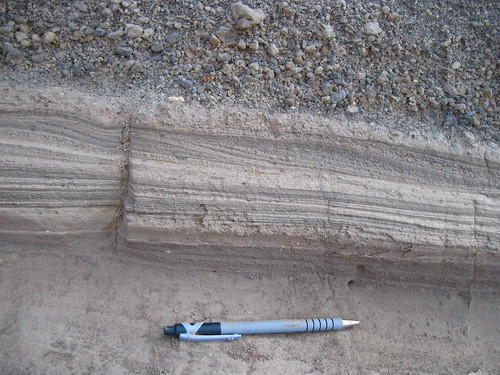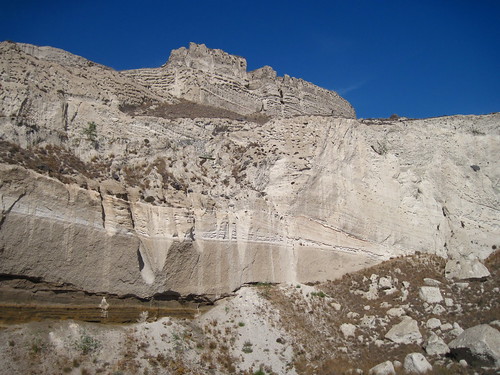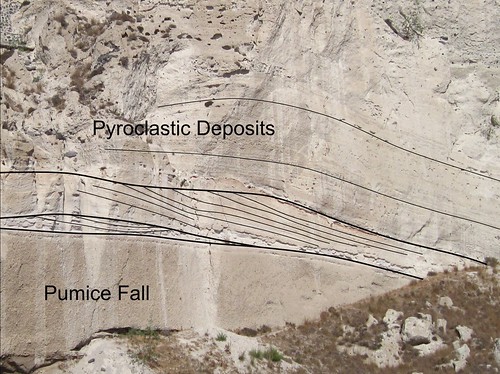Before I start, a little bit of history; why is this a significant eruption? The Minoans were a powerful Bronze Age civilisation on Crete. Their power came from their trade network, stretching from western Europe to the middle east. Thera was an important part of this network, although it appears to have had some independence. This all came to an end some time in the 17th century B.C., and the chief suspect is the eruption of Santorini.
Atlantis recreates this event in some detail, and to the BBC's credit, pretty accurately. Of course, there is still a fair amount of uncertainty in the recreation, but the program closely reflects current scientific thinking.
Before coming to the eruption itself, however, I want to first talk about the reconstruction of the island. Below is a Google Map of the island today (really a group of five islands), but the Minoan eruption had a profound effect on the topography. The map shown on Atlantis was similar, but subtly different. How did they go about drawing it?
View Larger Map
Perhaps the biggest surprise is that the Bronze Age island looked so similar. The Minoan eruption undoubtedly lead to the formation of a new caldera (or volcanic crater), as well as adding several square kilometres to the outside of the island in new pyroclastic flow deposits. Yet Atlantis showed an island with a large caldera at its centre. How can we tell there was already a caldera there that the Minoan eruption then enlarged, rather than a complete island that was torn apart for the first time? There are two pieces of evidence that lead us to this conclusion. The first is rather simple. Some of the cliff faces are plastered with the products of the Minoan eruption. If the cliff faces are covered in eruption products, then the cliff faces must have been there before the eruption. The second shows that not only was there a caldera present, but that it must have been filled with sea water. Stromatolites are a kind of microbial mat, which from distinctive domes. They only grow in marine conditions, and are found in the volcanic deposits from the Minoan eruption. A study mapped out their occurrence in the Minoan products, showing how there must have been a shallow sea in the centre of the island. The stromatolites would have been ripped up from their resting place during the eruption.
Atlantis also showed an island at the centre of Santorini's ancient caldera. The two Kameni islands that currently occupy the caldera are young, however. Palea Kameni, the older of the two, only broke the surface in 197 B.C. Is Atlantis wrong? Probably not, as there is evidence for an older island. In the Minoan deposits there are blocks of lava that cannot be matched to any of the lava flows uncovered on Santorini today. The most likely explanation for these is an island similar to the present day Kamenis, that was sunk or blown apart by the eruption and caldera collapse.
Having explored the bronze age geography of Santorini, lets look now at the eruption. This can be reconstructed by looking at the deposits left behind.
The first stage of the eruption is shown as being a light ashfall. This is preserved as a thin ashband over most of the island at the base of the Minoan sequence. Below is a picture of something similar from one of the Lower Pumice eruptions on Santorini.
The lower, flat lying layers are the equivalent of this ash fall here.

One of the biggest clues to the method of deposition is the grain size. Small grains require little energy to transport, so where they are found to have been deposited must have been tranquil. While the eruption that produced this ash must have been at least a little violent, a short distance away it would have been calmer. These sorts of deposits are typical of ash falling out of a plume emanating from a vent and spreading out. How long this phase lasted is a major uncertainty. It depends on the rate of ash falling, as obviously higher rates of ash falling would take a shorter amount of time to build up the same thickness deposit as under lower rates of ash production. Also note how above the flat layers are dipping, or 'crossbedded' layers. These are not found in the initial ash deposit of the Minoan, but I ill come back to them later.
After the ash fall came a pumice fall. How long after is also not well known; while the rocks record no break the ash could have lain around for months without being disturbed before the pumice fell. The Minoan pumice fall looks a lot like the pumice fall at the top of the picture above. This is a 'well sorted' deposit, showing that it likely originated from a fall rather than a flow. As pumice is carried by the wind in from a plume, it begins to fall. Heavier particle will drop out of the cloud first (as they require more energy to keep them aloft), meaning that at a particular distance from the origin of the plume most of the pumice falling will be the same size, leading to deposits 'sorted' by size. Pyroclastic flows, on the other hand, are far more chaotic leading to poorly sorted deposits.
Which brings us on to the pyroclastic deposits. These make up the vast bulk of the 30-60 km3 of magma erupted during this event. To put this volume into context, if the magma from the Minoan eruption was spread evenly over Manhattan, it would bury the Empire State Building. However, the 30-60 km3 is what's known as the 'dense rock equivalent'. Because pumice, and to a lesser extent the ash, tend to be a lot less dense than regular rock, the actual volume of the deposits is much larger.

Minoan deposits in a quarry south of Phira. At he base, above the brown, layered deposits is the thick grey Minoan pumice fall. Above that are the pyroclastic deposits, including some dune crossbedding.
The photo above gives an impression of just how thick the Minoan deposits can get. While the thick grey pumice fall at the base of the sequence has very little structure to it, if you look closely at the pyroclastic deposits above you can see layers (click on it to get a larger version). Following some of these layers, or 'beds', you should be able to see that some of them cut across the ones below. To make it clear, I've zoomed in and traced these beds on the picture below:

Close up if the dune crossbedding in the Minoan Pyroclastic deposits, from the photo above.
These, like the beds in the ash from the Lower Pumice eruption, are called crossbeds. They are commonly found in sedimentary rocks, where they are formed by migrating ripples in the stream bed. Sediment is deposited on the down-stream side, creating inclined beds. When another ripple passes, it begins to erode the previously deposited beds, cutting them off as can be seen above. Crossbeds, therefore, show that they were deposited by a moving current. While the crossbeds in the Lower Pumice ash are similar in size to those found in streams, the ones in the Minoan are much larger: metres in scale. The flows that deposited these were obviously very powerful. Anyone left on the island would not have survived after this.
These pyroclastic flows formed when the eruption column collapsed, firing sideways hot material that had been thrown high into the air. By mapping out the various layers found in the deposits we can build up a picture of a pulsating eruption, sometimes with a high column but sending frequent blasts out latterly to cover the island. Tsunami deposits are found on Crete, likely triggered by the collapse of the caldera floor to form the deep hole in the centre of the current island. The effect this must have had on the Bronze Age Minoans must have been devastating.
Did anyone from ancient Thera survive? No bodies have been found, unlike at Pompeii. The town of Akrotiri, discovered in the 1960s, shows signs of earthquake damage. This damage was not caused by the eruption itself, because the people of the town had started to clear it up before it was buried by the volcano. Did the locals abandon the island as well as their town before the end? With the thickness of the covering rock, we will probably never know.
References
Cioni, R. et al., 2000. Precursors to the plinian eruptions of Thera (late bronze age) and Vesuvius (AD 79): Data from archaeological areas. Physics and Chemistry of the Earth, Part A: Solid Earth and Geodesy, 25(9-11), pp.719-724.
Friedrich, W.L. et al., 1988. Existence of a water-filled caldera prior to the Minoan eruption of Santorini, Greece. Naturwissenschaften, 75(11), pp.567-569.




Comments